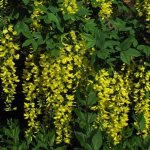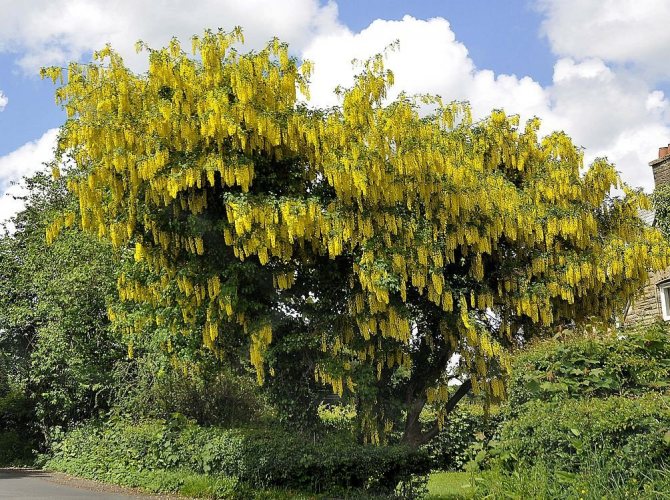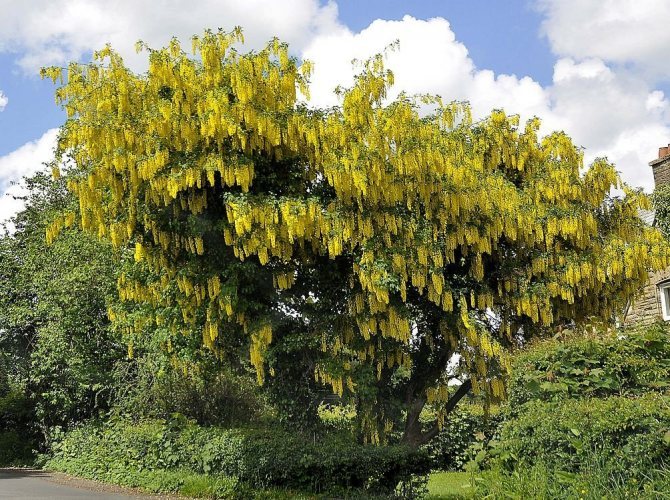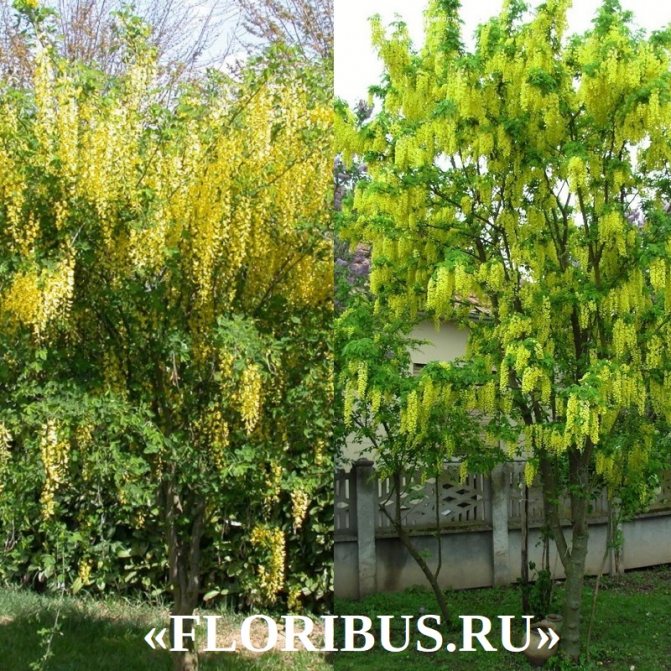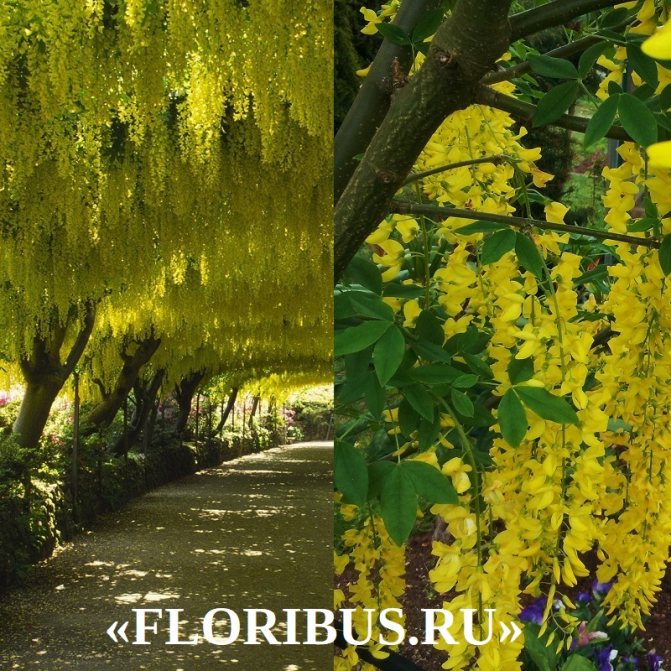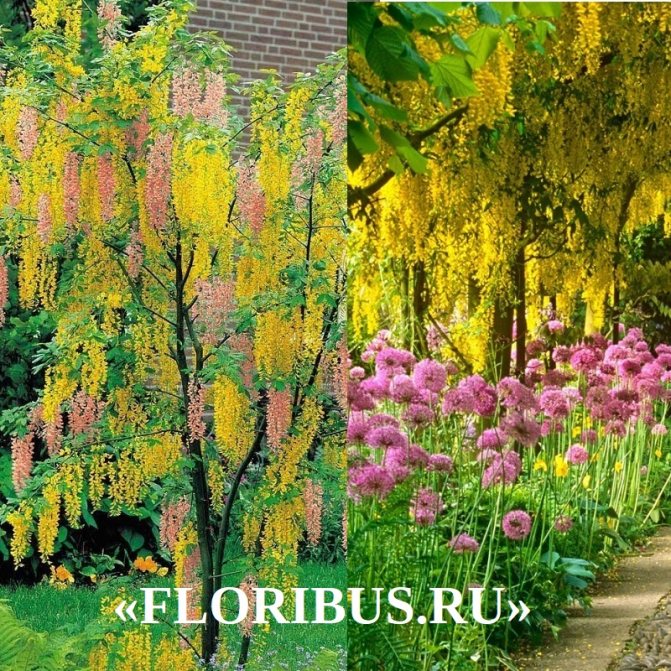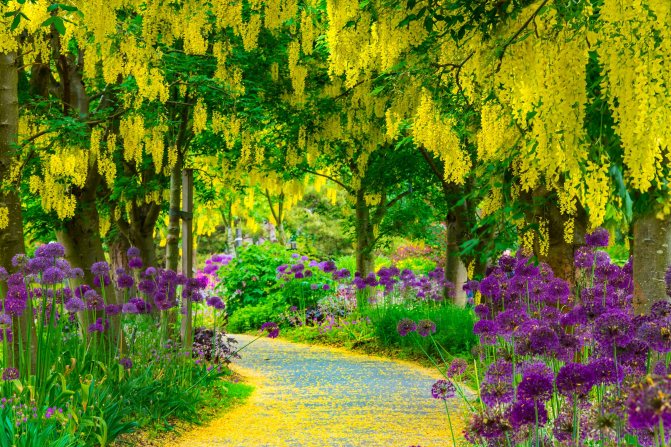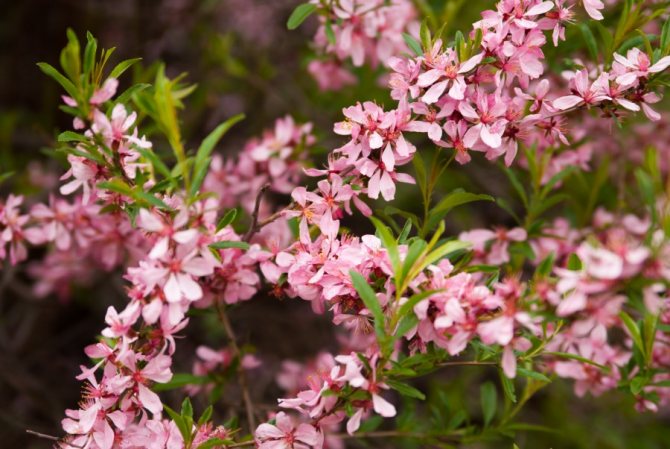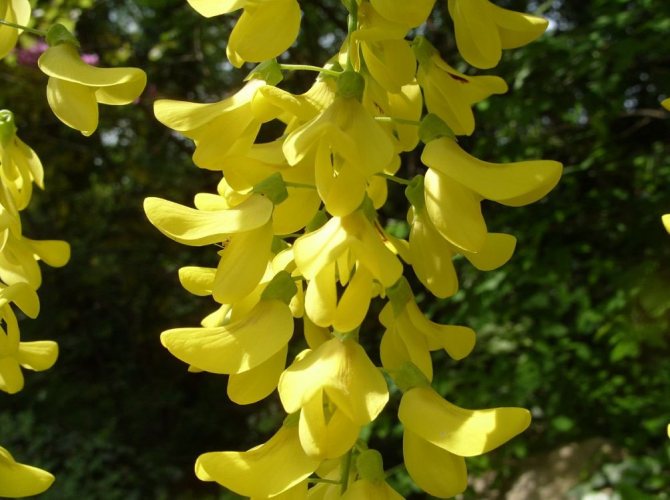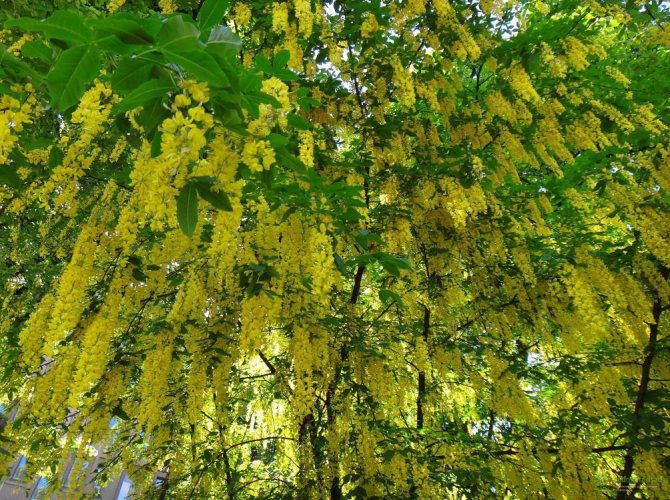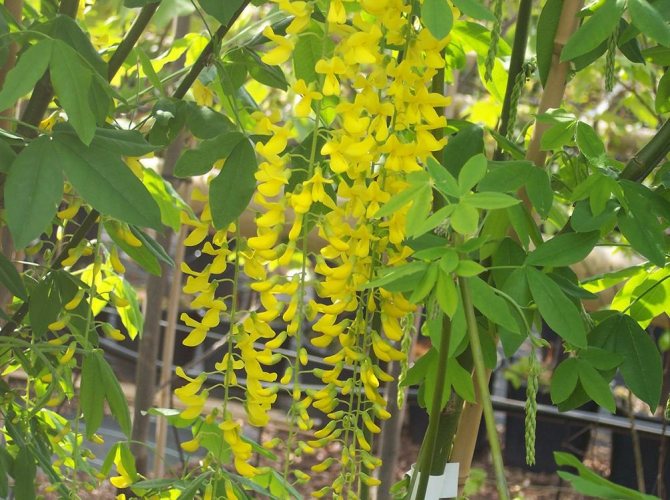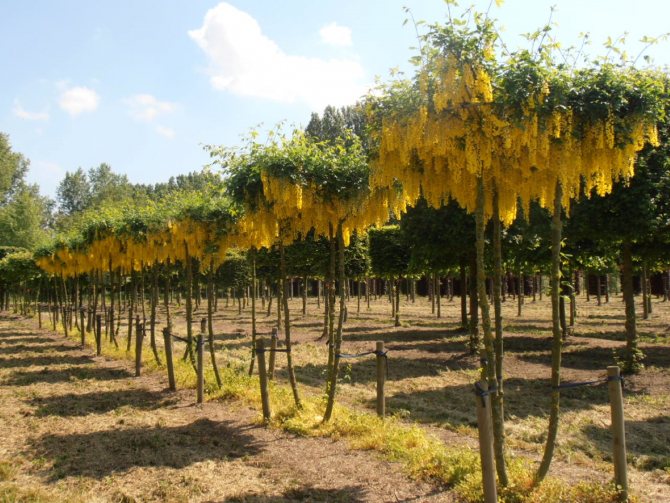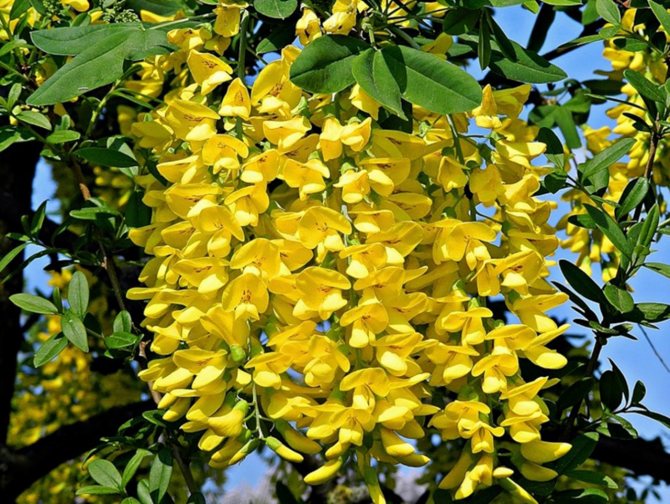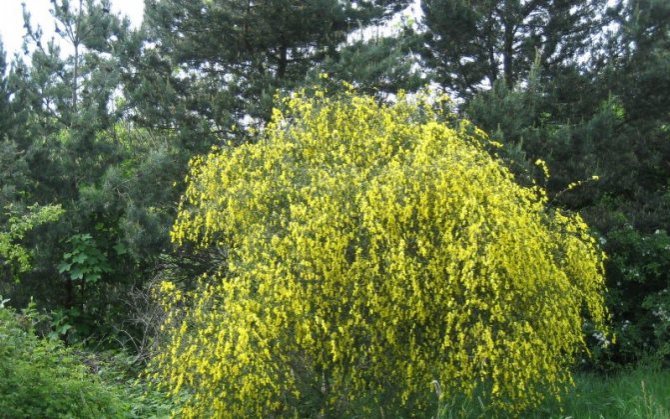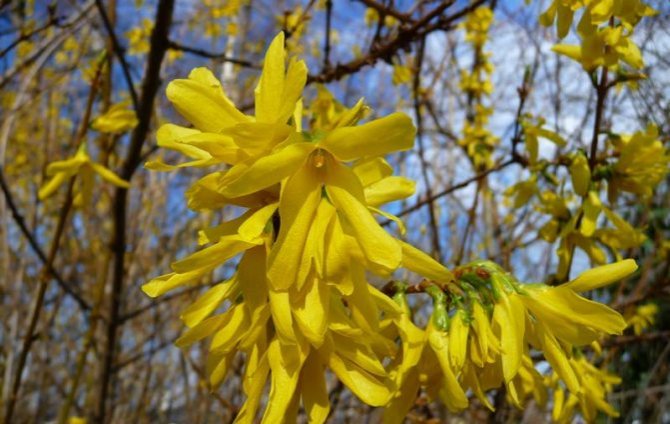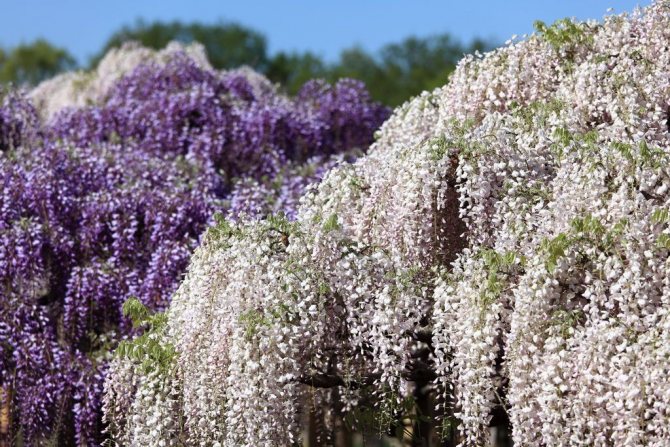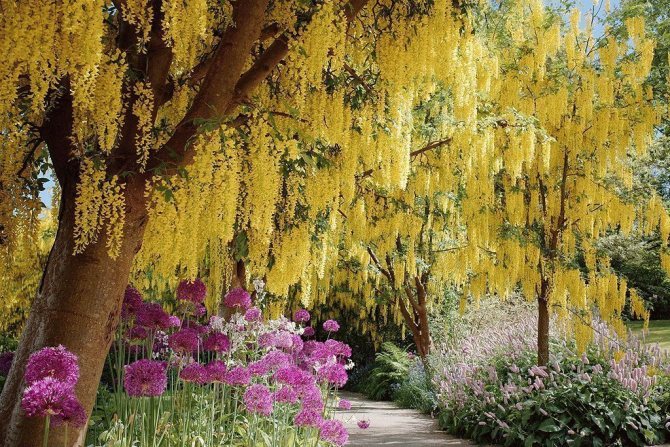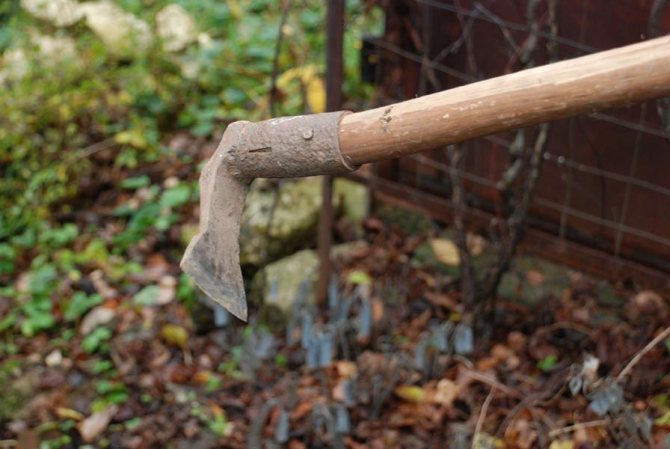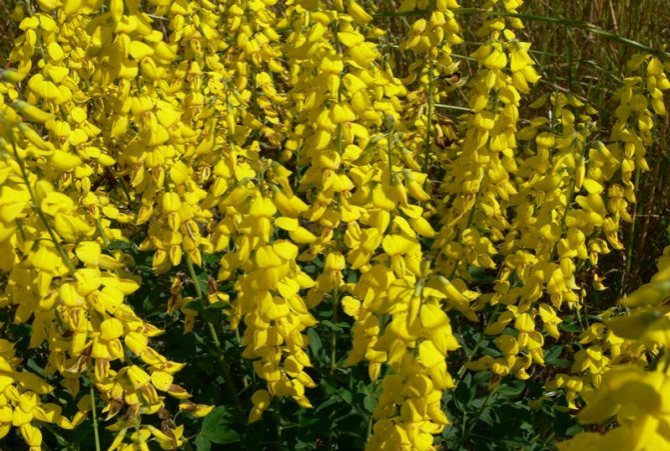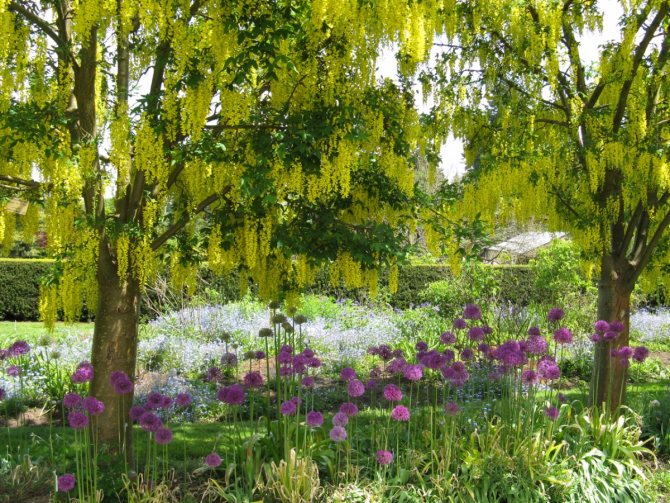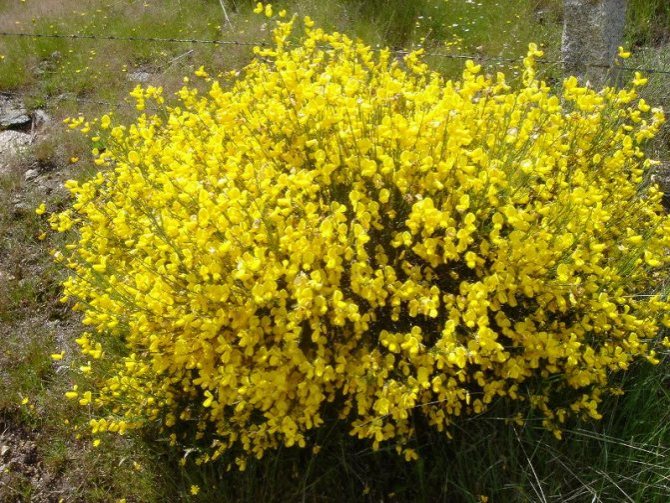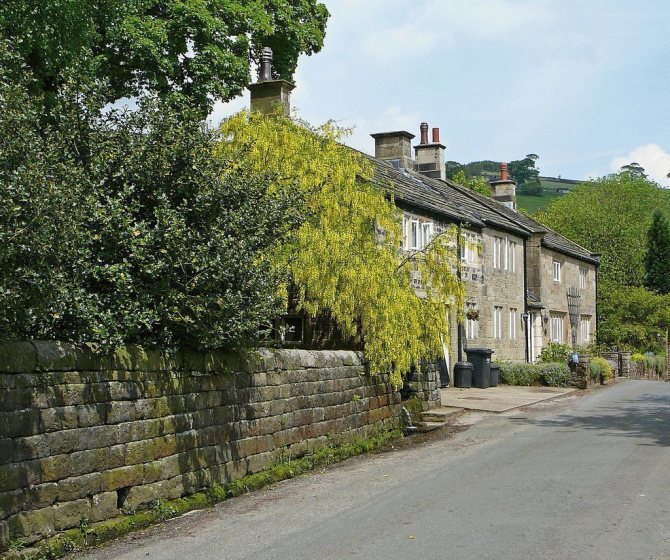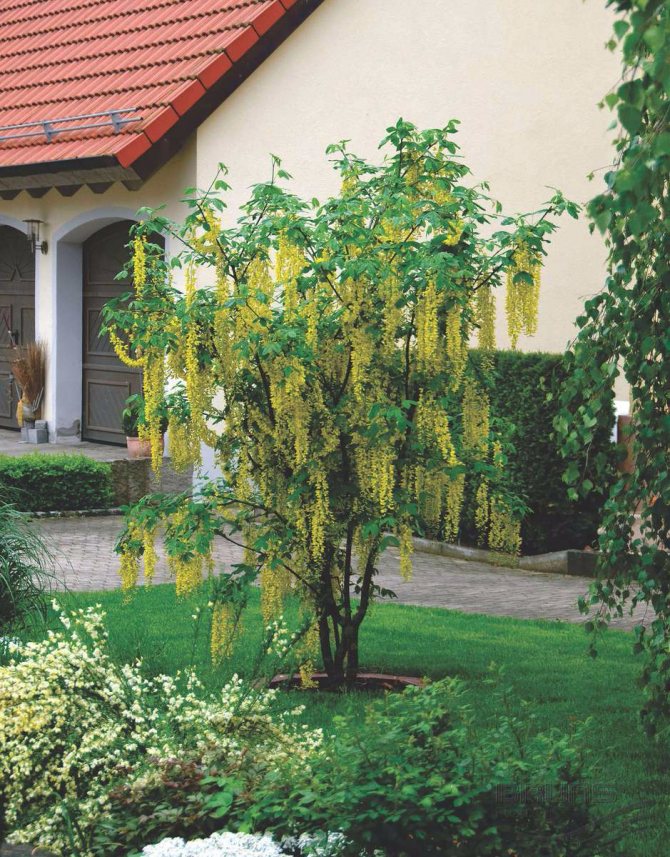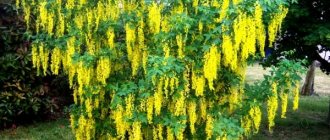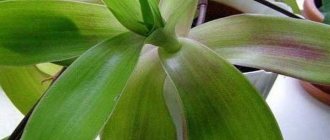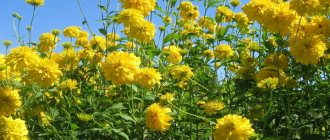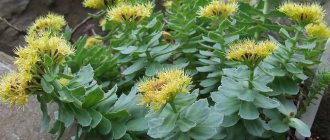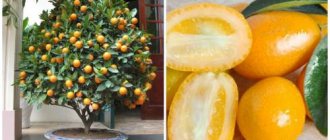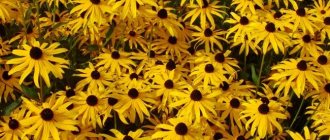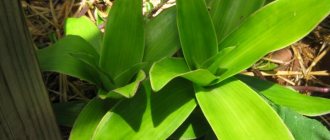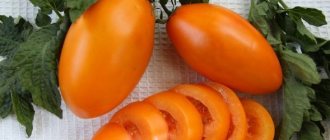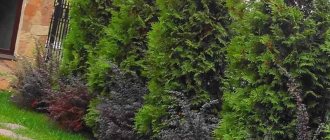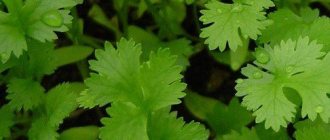| Family name | Legumes |
| Life cycle | Perennial |
| Growth features | Shrub or tree |
| Reproduction | Seed and vegetative (grafting, grafting or rooting of cuttings) |
| Landing period in open ground | Rooted cuttings, planted in July-August, seedlings in March |
| Substrate | Any nutritious, alkaline and loose soil |
| Illumination | Open area with bright lighting or partial shade |
| Moisture indicators | Moisture stagnation is harmful, watering is moderate, drainage is applied |
| Special Requirements | Unpretentious |
| Plant height | Up to 7 m |
| Color of flowers | Yellow |
| Type of flowers, inflorescences | Racemose |
| Flowering time | May June |
| Decorative time | Spring-summer |
| Place of application | Alleys, bersault and landscaping, as a tapeworm |
| USDA zone | 5–9 |
Until now, scientists have not clarified the etymology (origin) of the name of these representatives of the flora. There is a version that perhaps this is due to the Latin word "labrum", which translates as "lip", since the flowers have similar outlines, or a variant of the term "Lamiaceae" or "Labiatae", which refers to the word "labiate". Well, the name in Russian "bean" will not be able to convey all the beauty of the flowering of this plant, but, apparently, everything resembles the name of the family - Legumes. People can often hear how the most popular variety of anagyroid bean (Laburnum anagyroides) is called "Golden rain" or "Golden rain" broom.
All bean plants are deciduous plants that can appear like a small tree or shrub with spreading outlines. At the same time, its height reaches 7 m. The shoots become lignified over time, they are covered with a bark of a light brown color, decorated with specks. If the legume grows in the form of a tree, then often it can form more than one trunk, but several. The crown of the plant is formed by branches of weeping outlines. On the shoots, buds of a brown color, oval in shape, are formed and with the arrival of April they give rise to young leaves. The surface of the kidneys has 2-3 scales located outside. The foliage has a regular arrangement. The shape of the leaves is trifoliate; both stipules and long erect petioles are present. The color of the leaf plate is light green, the leaf lobes grow almost sessile. On the reverse side, the leaves have a fleecy pubescence, which is distinguished by a silvery tone. With the arrival of July, the color of the foliage acquires a more saturated green hue. The leaflet lobes are oval, the edge is even, and there is a sharpening at the top. The length of the leaf varies between 15-25 cm.
In the middle of May days, you can already admire the first flowers of trees or ornamental bean shrubs, which abundantly begin to decorate their shoots. Peduncles reach 20-50 cm in length. They are crowned with racemose inflorescences with a large number of buds. Inflorescences are hanging or erect, leafless. The color of the flowers is intense bright yellow.The shape of the bud is moth-shaped, at the calyx it looks like an irregular bell. Its length is 5 mm, the contours of the calyx are indistinctly two-lipped, with a pair of denticles on the upper lip, and three of them on the lower lip. The length of the petals varies from 2-3 cm, they grow free. In flower, the flag (or sail) is much longer than the wings and boat. The surface of the latter is bare. The sail may have red streaks at the base. There are 10 stamens, they differ in splicing. When flowering near plantings of bean trees or bushes, a sweet honey aroma is carried. Because of this, the flowering bean is considered an excellent honey plant. The flowering process will take 2-3 weeks.
After pollination on the bean branches, fruits ripen in the form of beans, which crown a long leg. The shape of the fruit is linear and flattened. There is a thickening at the seams or the beans may have small wings. They open late, exposing one or more seeds. The surface of the beans has a silky pubescence. The length of the pod reaches 8 cm, the size of the seeds does not exceed 3 mm. The shape of the seeds is flattened.
Decorative alleys are formed from laburnum or used as a tapeworm plant. The berso, which is a covered gallery made of crossbeams and placed along the garden paths, is also being planted.
Description of the bean
Bobovnik (laburnum) is a perennial deciduous tree or spreading shrub up to 7 m tall. Light brown speckled bark covers woody shoots. Often a tree can consist of several trunks. The crown is oval, consisting of falling weeping branches. In early April, foliage hatch from oval brown buds.
The branches quickly cover the trifoliate leaves of a bright green color. Below the leaves have a silvery sparse pile. The color of the leaves by the middle of summer becomes darker and more saturated. The leaf plate is oval with smooth edges and pointed ends, mounted on an erect, long petiole. The length of the leaf is 15-25 cm.
How the legume blooms
By mid-May, racemose dense inflorescences bloom on flexible long peduncles (20-50 cm). The flowers exude a sweet heady scent, attracting insects to collect nectar. It blooms very profusely. The yellow flowers have a characteristic moth-like shape for the legume family. One wide petal, covered at the base with reddish strokes, wraps over a keeled lip, consisting of the lower fused petals. Leguminous flowers bloom from two weeks to 20 days.
After pollination by insects, brown beans covered with silky pubescence will begin to ripen. The beans are up to 8 cm long.
If you decide to have a legume in your garden, remember that it is poisonous. and it is in the fruits that the greatest amount of toxins is found. Planting this plant is not recommended if the family has small children: even a couple of seeds they eat can be fatal.
Important nuances of care
In order for the bean plant to grow well and please with its beauty, it is necessary to carefully look after it. Trees and shrubs take root in the subtropics. When grown in central Russia, it is imperative to cover it. Particular attention should be paid to plants under 4 years of age.
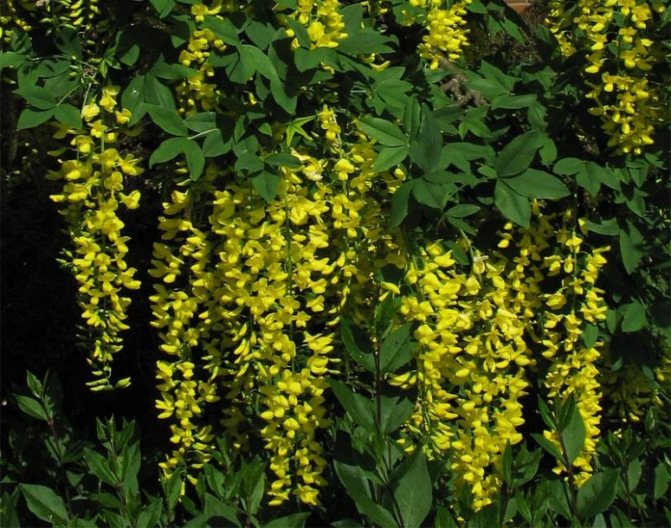
It is necessary to shake off the snow. If the plant has damaged branches, you need to carefully remove them. Hybrid seedlings are not pruned. To avoid watering the plant in summer, compost should be added in mid-spring. This material retains moisture and nutrients. Decorative haircuts are not recommended, as they disrupt the growth of garden culture. The procedure can be performed once, when the plant is one and a half years old. The legume plant requires attention, planting and care in the suburbs can be difficult.
Thorny blue spruce: description of the species, varieties, cultivation features
Laburnum is poisonous... Seeds are especially dangerous. You can not eat them, it is fraught with death. Gloves should be worn in contact with the plant and planting material. Children and animals should not come into contact with laburnum. The plant is combined with low-growing trees and shrubs. The best neighbors are wisteria and hawthorn.
How to plant and care for beanberries
Seat selection
Find a sunny, open area for your thermophilic bean. It can develop normally and in partial shade. Make a spacious hole for planting. Be sure to place a good thick drainage layer on the bottom. Do not deeply deepen the seedling. It is better to tie up young flexible shoots to a solid support so that they do not lean in different directions and do not break.
Soil and watering
Choose a nutritious, well-drained soil for planting. Preferably choose an alkaline soil, if the soil is acidic, leaching will be required (you can add wood ash or a little lime, they do this in autumn to prepare the soil for spring). Bobovnik has a negative attitude towards soil compaction and water stagnation. It is better to mulch the soil surface with moss or peat so that a crust does not appear after watering.
The plant tolerates drought much better than excessive moisture. Therefore, it is necessary to water during periods of prolonged drought. Good watering will be required during the flowering stage.
Top dressing
During the period of active growth, the tree needs microelements. Use organic fertilizers as top dressing. In the spring, mulch the soil with compost. Several times a season, mullein solution can be poured under the root.
Pruning
Formative pruning is practically not needed by the bean. Even without human intervention, the cascading shoots will take a beautiful shape. You can remove some of the branches and frozen shoots in the spring. Do this in moderation to keep the laburnum from getting sick. If possible, remove the beans after flowering to prevent self-seeding and increase the tree's attractiveness.
Most of the bean branches are sloping in shape, so a lot of snow accumulates on them in winter. To prevent them from breaking under such a weight, part of the snow embankment must be shaken off.
Diseases
If the weather is damp or the soil is overly moist, powdery mildew can infect the legume near the trunk. In this case, a grayish bloom will appear on the branches and trunk. If you find such signs, improve the conditions of care and treat with a fungicide. Due to its toxicity, the legume is not affected by pests.
Growing legumes from seeds
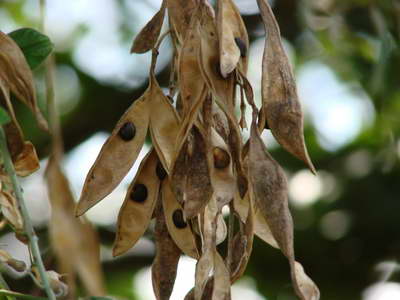

How to grow leguminous plants from seeds photo seeds
Leguminous plants can propagate by seeds and vegetatively. Seeds germinate for about three years, but it is better to use fresh seeds.
- Before sowing, the seeds can be left untreated, but it is better to stratify (keep them in the refrigerator for a couple of weeks before sowing, preferably mixing with damp earth or in damp gauze, wrapped in a bag).
- Sow in loose, fertile soil.
- You can sow Laburum before winter, or immediately after the thaw in spring.
- The seeding depth is 1-2 cm, the distance between the seeds is 10-15 cm.
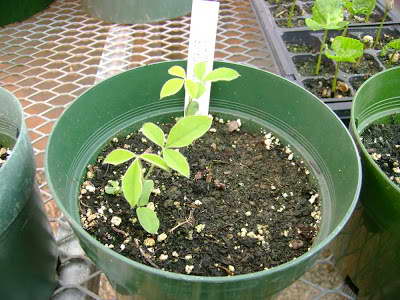

Bobovnik laburum from seeds photo shoots
- Seedlings do not need special care, they will develop well.
- You can grow bovovnik through seedlings on the windowsill, sowing in the month of February. Seedlings will need good lighting and moderate watering.
- Gently dig up the grown trees with a large earthen clod (or free from seedling pots) and transplant to a permanent place of growth.
- The seed-grown bean will bloom in 4-5 years.
Laburnum breeding methods
Summer residents propagate the crop using seeds. Planting material becomes ready in mid-autumn. The beanberry has large seeds. It is best to sow them immediately after harvest. You should first loosen the ground. The planting material is buried by 1 cm. In the spring, sprouts appear.
What are the names and where are the fruits and leaves of maple used?
If it is not possible to sow laburnum in the fall, you can do it in early spring, when the soil is saturated with moisture. Seed propagation has disadvantages. It is not suitable for hybrid varieties. If the summer resident sowed seeds and properly cares for the bean, flowering begins only after 5 years. There are other methods as well.
There is another way. Bobovnik golden shower is propagated using layers:
- They take one middle branch and die in the ground;
- Sprinkle with fertile soil;
- Press down slightly, fix.
After 12 months, it turns into a small tree with a root system and its own branches.
Hybrids are propagated by cuttings. Planting material is harvested in the spring. It is necessary to cut off the stalk, which has several buds. Cuttings are planted in pots. Water them sparingly but regularly. Waterlogging of the soil is also harmful. Cuttings sprout quickly.
How to propagate leguminous plants vegetatively
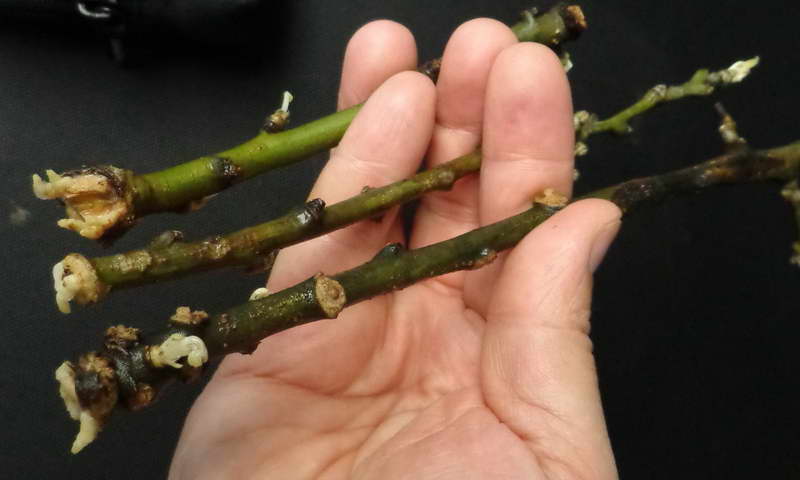

Reproduction of bean cuttings photo
Vegetative breeding methods are the most successful. Varietal plants are recommended to be propagated vegetatively in order to preserve their unique differences. You can use the following methods:
- Cutting: in July-August, cut young shoots, rooting in loose soil in partial shade. Cover the cuttings with a cap until roots form, water carefully. Such plants will need shelter for the winter in the first year of life.
- Vaccination: a varietal cutting should be grafted on a specific rootstock. Locate the vaccination site near the ground.
- Layers: bend the lower shoot to the ground and sprinkle with soil. In the place where the roots should appear, it is recommended to apply several cuts to the bark. After about a month, the roots will appear, the shoot can be cut and planted separately.
Layers
Young shoots are pressed against in early spring. To form roots, before digging in a branch, it is necessary to cut off the bark or make cuts on it. The use of growth stimulants will speed up the root formation process. Vertical shoots will appear on the rooted branch next spring. The daughter plant is separated from the mother plant in a place with soil, taking care not to damage the roots.
The main difference between the bean and other ornamental trees is the large drooping clusters of yellow flowers (sometimes they have pink or white shades). Blooming brushes reach half a meter, exude a delicate aroma. With proper care, the tree begins to bloom in late spring and lasts for about a month. At the end of flowering, seeds are tied. These are large enough beans, with the help of which the tree conquers new territories. Bobovnik reproduces well by self-seeding. In the photo, the bean flowers look like a flock of bright light-winged butterflies. Recommendations for proper crop cultivation and planting dates in open ground will be discussed in detail in this article.
Types of bean with photos and names
The legume genus consists of only two species, one hybrid tree and several varieties.
Anagyrolist bean Laburnum anagyroides
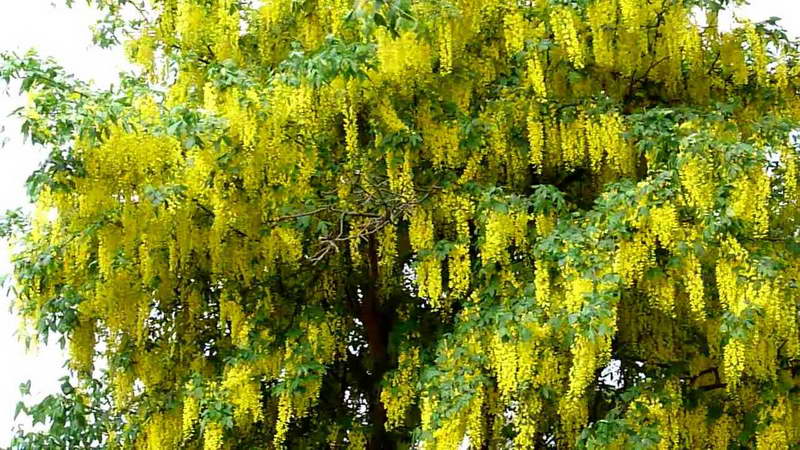

Anagyrolist bean Laburnum anagyroides photo
It is also called "golden rain". It is a bush or multi-stemmed tree about 6 m high. The inflorescences are about 30 cm long. Flowering will begin in May and will last about a month. Able to withstand frost down to -20 ° C.
Alpine bean, Laburnum alpinum
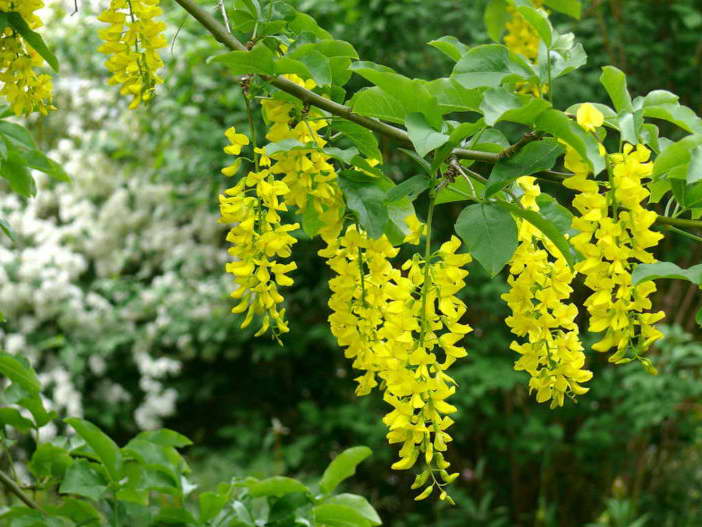

Alpine bean Laburnum alpinum photo
The tree is up to 12 m high, the crown is spreading, oblong. The old branches and trunk are erect, the edges of the shoots droop. Yellow inflorescences 30-45 cm long bloom by the end of May. The plant itself is able to withstand temperatures as low as -25 ° C, but the ends of the branches can freeze. The plant is common in southern Europe.
Decorative varieties are:
- Pendula - with long, drooping shoots;
- Aurea - in spring, young foliage has a golden tint, but gradually it acquires a rich green color;
- Quercifolia - cut-shaped leaves of the type of oak;
- Automnale - presents with flowering not only in spring, but also in autumn.
Bobovnik Vaterera Laburnum x watereri (hybrid)
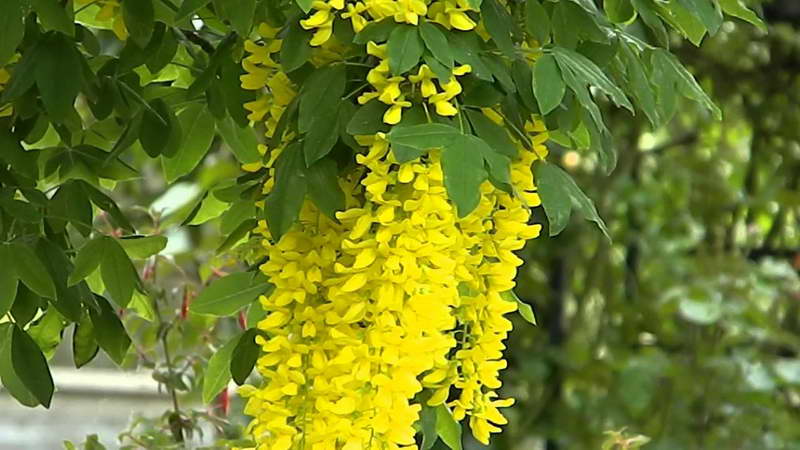

Bobovnik vaterera Laburnum x watereri ‘Vossii’ photo
Obtained as a result of crossing the two previous species. It is a bush or tree 1-3 m high. Old erect shoots complete drooping shoots. The leaves are petioled, reaching a length of 50 cm. The flowers exude an intense pleasant aroma. It is grown mainly in the southern regions, because the plant is sensitive to frost.
Varieties
In the period from mid-May to mid-June, when the bean flowers bloom, the illusion is created that golden rain is pouring from the green branches. This is what the people call this plant. A tree that reaches a height of up to 3 m in the Moscow region, with dark green leaves and bright yellow clusters 30 - 50 cm long - common bean or anagirolis. The species is commonly used for landscaping gardens. Its varieties are distinguished by the color of the flowers.
In the gardens, there are bushes entirely covered with pale pink flowers - this is a pink bean. The period of its flowering is short, only 2 weeks, but the bushes retain their decorative effect throughout the summer due to their immunity to almost all types of diseases.
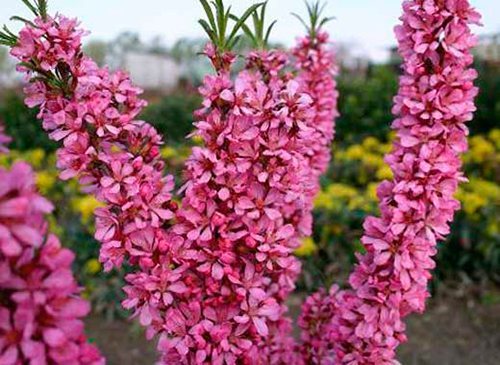

Bobovnik in garden design
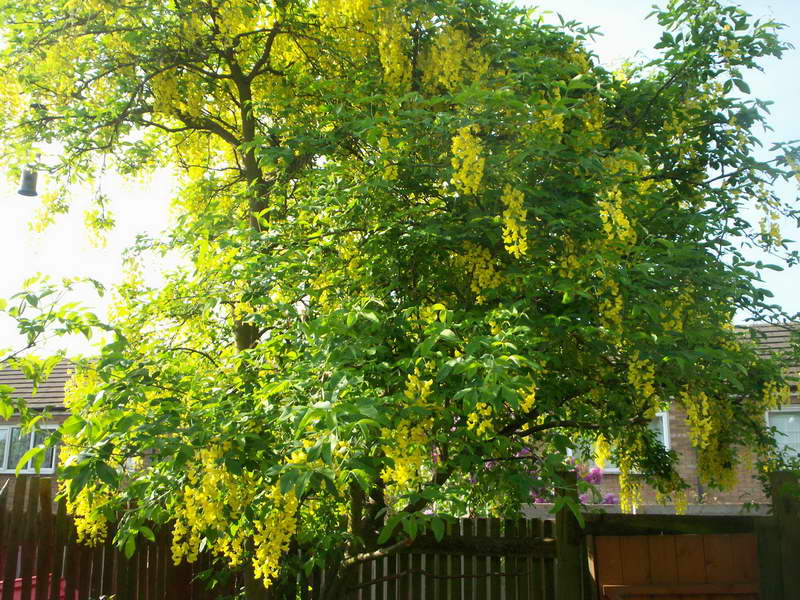

Bobovnik in landscape design photo
Bobovnik will become a real "golden" decoration of your garden. Plant individual trees solo anywhere in the garden. The gazebo, located under the spreading crown, will become an even more comfortable resting place. Long liana-like shoots can be directed along the arch, other supports, creating a magical cascade, a corridor.
Bobovnik is suitable for being close to rhododendron, hawthorn, wisteria or scumpia. Juicy greenery and bright inflorescences will stand out against the background of conifers in dark green or bluish tones.

